Global Ceramic Tiles Market Forecast
- Global ceramic tiles market size to be worth US$379.25 Bn by 2030, witnessing a rise from US$228.6 Bn recorded in 2022
- Ceramic tiles market valuation likely to rise high at a CAGR of 7.5% between 2023 and 2030
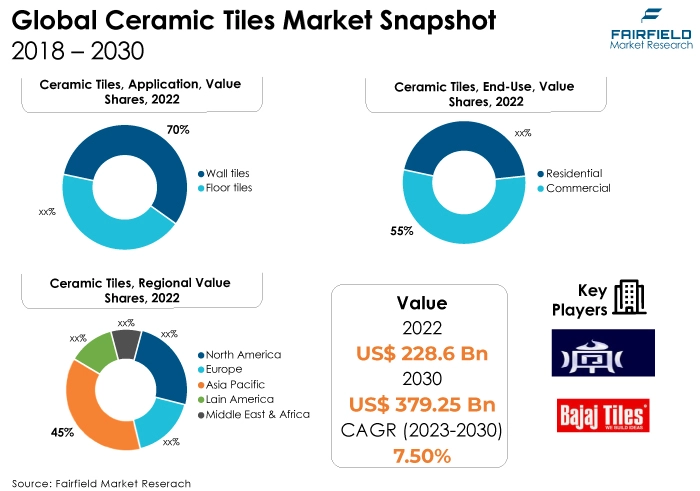
Quick Report Digest
- The key trend anticipated to fuel the ceramic tiles market growth is that A sizable portion of the global construction and building materials market is devoted to ceramic tiles. Furthermore, sustainable and eco-friendly tiles are becoming increasingly popular in the ceramic tile market.
- Another major market trend expected to fuel the ceramic tiles market growth is Tiles made from recycled materials, tiles with low emissions, and goods that adhere to environmental standards are becoming more and more in demand from customers and builders.
- In 2022, the glazed ceramic tiles category dominated the industry. Glazed ceramic tiles are available in a wide selection of patterns, colours, and designs, providing a wide range of aesthetic choices. Glazed ceramic tiles come in a wide variety of styles, so you can find one that suits your preferences, whether traditional, contemporary, or custom.
- In terms of market share for ceramic tiles globally, the floor tiles segment is anticipated to dominate. Living rooms can benefit from the elegance and durability of ceramic tiles. Tiles that resemble wood or stone are among the many styles and designs available.
- In 2022, the commercial category controlled the market. Due to their resilience, aesthetic versatility, and low maintenance requirements, ceramic tiles are a popular option for many applications in commercial buildings.
- Despite being healthy, the market for ceramic tiles faces numerous obstacles that could impede its expansion and progress.
- The Asia Pacific region is anticipated to account for the largest share of the global ceramic tiles market; rapid urbanisation and a boom in Construction are two trends that are permeating Asia Pacific. Construction projects for homes, businesses, and infrastructure have increased as a result.
- The construction industry significantly influences the market for ceramic tiles in North America. For flooring, backsplashes, and bathroom surfaces, ceramic tiles are frequently used in construction and renovation projects in both residential and commercial settings.
A Look Back and a Look Forward - Comparative Analysis
The market for ceramic tiles has grown in popularity due to factors such as construction and infrastructure development, which are the main factors driving the ceramic tile market. Ceramic tiles are widely used in the flooring, wall cladding, and other interior and exterior applications of the construction industry, which includes residential, commercial, and industrial projects.
Globally, urbanisation and construction activity are on the rise, and ceramic tile demand is rising along with it. The market witnessed staggered growth during the historical period 2018 – 2022. Both the phenomena are occurring simultaneously as the world's population continues to rise. This urbanisation trend increases demand for homes and businesses, raising the need for ceramic tiles for interior and exterior applications.
Ceramic tile remodelling and renovation projects are also driven by urbanisation. Disposable incomes are rising, especially in emerging markets, as the world's economies mature. Ceramic tiles are a popular choice for enhancing the aesthetics and functionality of living spaces. Higher disposable incomes result in more lavish home improvement and interior decor spending.
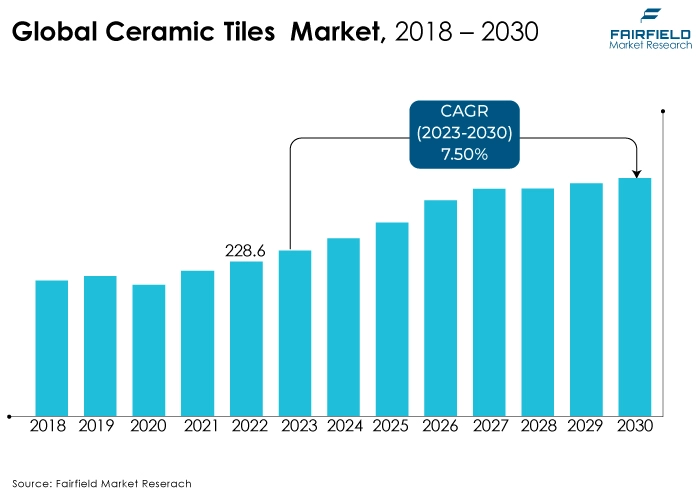
Key Growth Determinants
- Growing Demand for Eco-friendly Products
Concerns about the environment have sparked a demand for eco-friendly building materials, including ceramic tiles. As a response, producers are creating recycled material tiles, implementing eco-friendly production techniques, and employing sustainable sourcing methods. Environmentally conscious buyers and builders favour eco-friendly tiles.
- Rapid Technological Advances, and Innovations
Rapid technological advancements have enabled the innovation in ceramic tiles in terms of designs, sizes, and durability. The use of intricate, scalable designs on tiles is made possible by digital printing technology, improving their aesthetic appeal.
The expansion of ceramic tile markets is a result of trade and globalisation. Because of the wide range of consumer preferences and rising global demand, manufacturers are exporting their goods to numerous regions.
- Renovation and Remodelling Projects Across Industries
A significant market driver for ceramic tiles is the renovation and remodelling sector. Ceramic tiles are frequently chosen because of their adaptability and aesthetic potential when homeowners and businesses want to renovate or upgrade their spaces.
A sizable portion of the consumption of ceramic tile comes from renovation projects. Healthcare facilities, kitchens, and bathrooms prefer ceramic tiles, especially those with antimicrobial qualities. These tiles contribute to keeping a more sanitary environment, which is a big motivator in some industries.
Major Growth Barriers
- High Energy Consumption
The processes of glazing and firing ceramic tiles both require significant energy inputs. Rising energy prices may threaten the sustainability, and profitability of the ceramic tile industry, and worries about their effects on the environment.
Strict environmental regulations may have an impact on the production of ceramic tiles. Emissions regulations and waste disposal guidelines must be followed by manufacturers, which can raise production costs and influence the selection of raw materials.
- Availability of Numerous Manufacturers
Due to the numerous manufacturers that operate on a global scale, the ceramic tile market is very competitive. Price pressure and smaller profit margins for manufacturers are frequently effects of fierce competition.
Global supply chains are connected to the ceramic tile market for raw materials and distribution. These supply chains can be disrupted by natural disasters, trade disputes, or geopolitical tensions, resulting in delays and higher production costs.
Key Trends and Opportunities to Look at
- Design and Appearance
The design and appearance of ceramic tiles have been revolutionised by digital printing technology. It can accommodate a variety of architectural and interior design preferences and offers intricate patterns, textures, and unique designs.
Ceramic tile's artistic potential has increased thanks to this technology. Large-format ceramic tiles, also called slab tiles, are becoming increasingly well-liked. These large tiles, up to 5 feet long, have fewer grout lines and a sleeker, more contemporary appearance.
- Wood-Look and Stone-Look Tiles
Ceramic tiles that resemble wood and natural stone have grown in popularity. Despite having the durability and low maintenance requirements of ceramic tiles, they offer the aesthetic appeal of natural materials. These tiles are frequently used in residential and commercial spaces as wall and floor coverings.
- Smart Tiles
A developing trend in ceramic tile design is the incorporation of technology. Bright tiles can incorporate features like embedded LEDs, heating elements, or even connectivity for home automation systems. Beyond just being attractive, these tiles can also serve additional purposes.
Customers are increasingly looking for distinctive designs and personalised tiles. Customers can now design their tile patterns, colours, and shapes due to customisation services provided by manufacturers. This fashion appeals to those looking for a distinctive style.
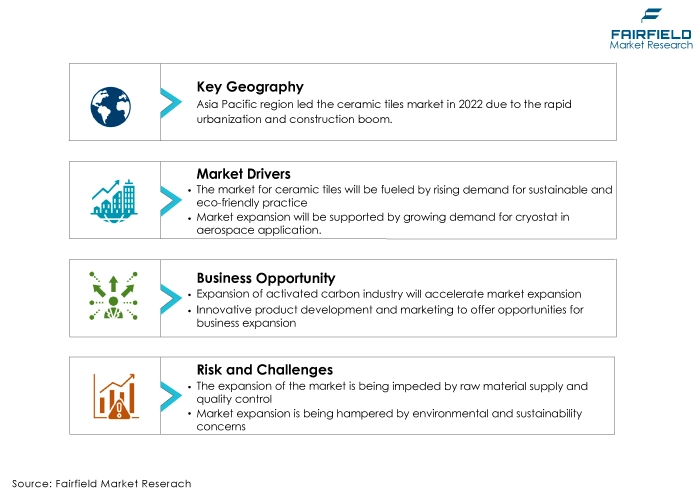
How Does the Regulatory Scenario Shape this Industry?
The airborne particles that are suspended but do not become dust are this. The SPM released, also known as SPM-10, has a diameter of less than 10 m. The comminution, sizing, classification, handling, transfer, and storage of ceramic products all produce these suspended particulate matter emissions.
Filterable and condensible SPM, which may also contain inorganic pollutants, are released by calciners. In addition to volatile organic compounds (VOC), nitrogen oxides (NOx), sulfur oxides (SOx), carbon dioxide (CO2), and carbon monoxide (CO), calciners also release other byproducts of combustion.
Fairfield’s Ranking Board
Top Segments
- Glazed Ceramic Tiles Dominate over Porcelain Tiles Category
Ceramic tiles are highly resistant to water and stains thanks to the protective layer created by the glaze applied to them. Due to this characteristic, glazed ceramic tiles are the best choice for bathrooms, kitchens, and other spill-prone areas.
Furthermore, the porcelain tiles category is projected to experience the fastest market growth. Industries that prioritise product security, aesthetics, and efficiency in packaging can benefit from porcelain ceramic tiles. This allows them to be used inside and outside without losing their colour.
- Floor will Surge Ahead Throughout the Forecast Period
In 2022, the floor category dominated the industry. Living rooms can benefit from the elegance and durability of ceramic tiles. Tiles that resemble wood or stone are among the many styles and designs available.
The wall category is anticipated to grow substantially throughout the projected period. Office spaces with ceramic tiles exude professionalism, and sophistication. They are strong and offer a tidy, low-maintenance solution.
- Commercial Sector Leads the Way
The commercial segment dominated the market in 2022. Due to their aesthetic appeal and ease of cleaning, hotels frequently use ceramic tiles in their lobbies, hallways, and guest rooms.
In educational settings, ceramic tiles are preferred because of their durability and low maintenance requirements. They can withstand heavily used spaces like hallways and cafeterias.
The residential category is expected to experience the fastest growth within the forecast time frame. In educational settings, ceramic tiles are preferred because of their durability and low maintenance requirements. They can withstand heavily used spaces like hallways and cafeterias.
Regional Frontrunners
Asia Pacific Remains in the Bandwagon
China, and India are experiencing rapid economic growth. Due to increasing disposable incomes, the demand for ceramic tiles in these markets is rising as more people can afford home ownership and home improvement projects.
Asia Pacific countries are making significant investments in the construction of transportation, healthcare, and educational infrastructure. Due to their strength, beauty, and ease of maintenance, ceramic tiles are frequently used in these projects.
Both residential and commercial properties are in high demand in Asia Pacific. Ceramic tiles are a popular option for flooring and interior design as developers try to make their projects look more appealing.
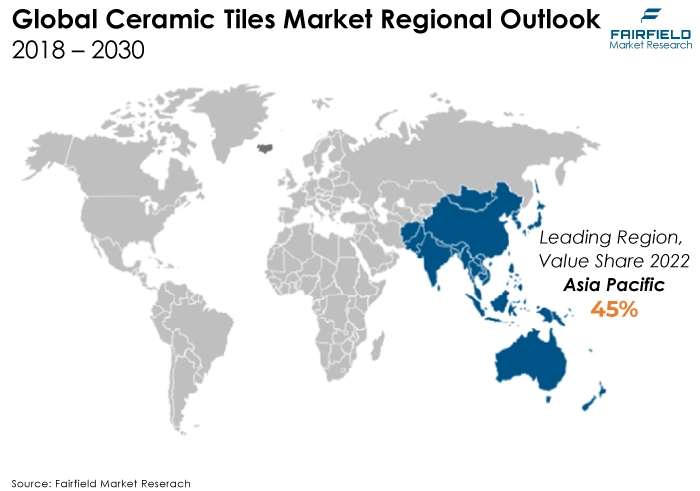
North America Jumps on an Ascending Trajectory
The construction industry significantly influences the market for ceramic tiles in North America. For flooring, backsplashes, and bathroom surfaces, ceramic tiles are frequently used in construction and renovation projects in both residential and commercial settings.
The construction industry significantly influences the market for ceramic tiles in North America. For flooring, backsplashes, and bathroom surfaces, ceramic tiles are frequently used in construction and renovation projects in both residential and commercial settings.
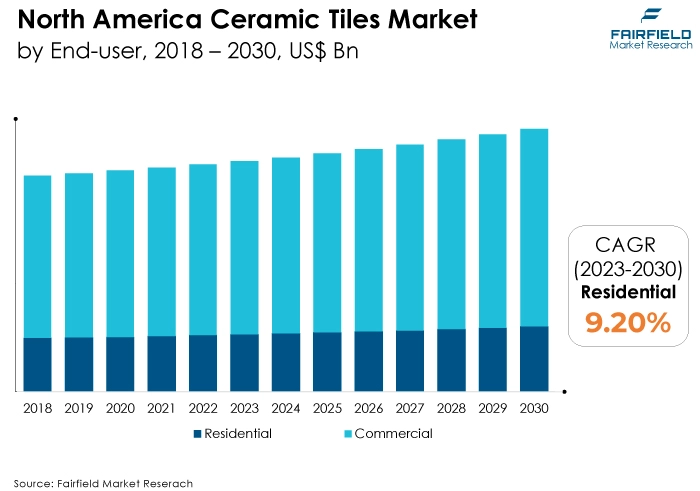
Fairfield’s Competitive Landscape Analysis
The global ceramic tiles market is a consolidated market with fewer major players present across the globe. The key players are introducing new products and working on the distribution channels to enhance their worldwide presence. Moreover, Fairfield Market Research expects more consolidation over the coming years.
Who are the Leaders in Global Ceramic tiles Space?
- Shiv Kripa
- Sri Srinivasa
- Johnson
- Kajaria
- Oriental
- Bajaj Tiles
- Somany Ceramics
- Cera Sanitaryware Ltd.
- Nitco
- Asian Granito India Ltd
- Simpolo
- H & R Johnson India Limited
- Accord Vitrified Private Limited
- Specto Ceramics (Noble Wall Tiles)
- Lavish Granito Private Limited
Significant Company Developments
New Product Launches
- July 2022: Hikvision recently announced the launch of a new AI-powered webcam. This AI-powered webcam has a 2k resolution, an integrated microphone, and precise autofocus.
- July 2021: A 4k 60P 10-bit PTZ web camera called the CR-N700 was introduced by Canon Canada in September 2022.
- The 10-inch CMOS sensor and 12G-SDI interface make it the perfect choice for professional studios, live events, and broadcast productions.
- November 2020: The Verbatim AWC-01 Full HD 1080p Autofocus Webcam with Microphone, Verbatim AWC-02 Full HD 2080p Autofocus Webcam with Light and Microphone, and Verbatim AWC-03 Ultra HD 4K Autofocus Webcam with a Dual Microphone are three new webcams that Verbatim introduced.
Distribution Agreement
- May 2021: China's ceramic tile production capacity represented nearly 53% of global production capacity. As a result, China had the highest capacity for producing ceramic tiles in the world that year. With a 9.3% share in that year, Europe's ceramic tile production capacity came in a far-off second.
An Expert’s Eye
Demand and Future Growth
China is the world's largest ceramic tile producer. Like Foshan, cities in the Guangdong province are renowned as manufacturing centres for ceramic tiles. The nation's vast construction sector, quick urbanisation, and export-oriented economy all contribute to its enormous production.
India is a significant ceramic tile producer, with essential manufacturing hubs in places like Morbi in Gujarat, and Sikandrabad in Uttar Pradesh. The domestic market, expanding economy, and export opportunities all favour the ceramic tile sector in India.
Various types of clay serve as the primary raw material for ceramic tiles. This includes feldspar, kaolin, and ball clay. The body of the tile is made from these clays.
Supply Side of the Market
Prominent clay suppliers include businesses like Imerys, Sibelco, and Quarzwerke Group. These businesses provide a variety of clay types used to manufacture ceramic tiles. Companies like Ferro Corporation, and Zircar Ceramics provide colourants, glazes, and other additives used in the production of ceramic tiles.
Many ceramic tile producers in countries like China, and India, where the ceramic tile industry is well-established, rely on local or regional suppliers for their raw materials. Businesses like Ferro Corporation, and Zircar Ceramics provide colourants, glazes, and other additives used in the production of ceramic tiles.
The Global Ceramic Tile Market is Segmented as Below:
By Product:
- Glazed Ceramic Tiles
- Porcelain Tiles
- Scratch-free Ceramic Tiles
- Others
By Application:
- Wall Tiles
- Floor Tiles
By End-use Sector:
- Residential
- Commercial
By Geographic Coverage:
- North America
- U.S.
- Canada
- Europe
- Germany
- U.K.
- France
- Italy
- Turkey
- Russia
- Rest of Europe
- Asia Pacific
- China
- Japan
- South Korea
- India
- Southeast Asia
- Rest of Asia Pacific
- Latin America
- Brazil
- Mexico
- Argentina
- Rest of Latin America
- Middle East & Africa
- GCC
- South Africa
- Egypt
- Nigeria
- Rest of the Middle East & Africa
1. Executive Summary
1.1. Global Ceramic Tiles Market Snapshot
1.2. Future Projections
1.3. Key Market Trends
1.4. Regional Snapshot, by Value/Volume, 2022
1.5. Analyst Recommendations
2. Market Overview
2.1. Market Definitions and Segmentations
2.2. Market Dynamics
2.2.1. Drivers
2.2.2. Restraints
2.2.3. Market Opportunities
2.3. Value Chain Analysis
2.4. Porter’s Five Forces Analysis
2.5. COVID-19 Impact Analysis
2.5.1. Supply
2.5.2. Demand
2.6. Impact of Ukraine-Russia Conflict
2.7. Economic Overview
2.7.1. World Economic Projections
2.8. PESTLE Analysis
3. Price Trend Analysis, 2018 - 2022
3.1. By Region
3.2. By Application
4. Global Ceramic Tiles Outlook, 2018 - 2030
4.1. Global Ceramic Tiles Outlook, by Machine Type, Value (US$ Bn), 2018 - 2030
4.1.1. Key Highlights
4.1.1.1. Glazed ceramic tiles
4.1.1.2. Porcelain tiles
4.1.1.3. Scratch-free ceramic tiles
4.1.1.4. Others
4.2. Global Ceramic Tiles Outlook, by Application, Value (US$ Bn), 2018 - 2030
4.2.1. Key Highlights
4.2.1.1. Wall tiles
4.2.1.2. Floor tiles
4.3. Global Ceramic Tiles Market Outlook, by End-use Sector, Value (US$ Bn), 2018 - 2030
4.3.1. Key Highlights
4.3.1.1. Residential
4.3.1.2. Commercial
4.4. Global Ceramic Tiles Market Outlook, by End Use, Value (US$ Bn), 2018 - 2030
4.5. Global Ceramic Tiles Outlook, by Region, Value (US$ Bn), 2018 - 2030
4.5.1. Key Highlights
4.5.1.1. North America
4.5.1.2. Europe
4.5.1.3. Asia Pacific
4.5.1.4. Latin America
4.5.1.5. Middle East & Africa
5. North America Ceramic Tiles Outlook, 2018 - 2030
5.1. North America Ceramic Tiles Outlook, by Machine Type, Value (US$ Bn), 2018 - 2030
5.1.1. Key Highlights
5.1.1.1. Glazed ceramic tiles
5.1.1.2. Porcelain tiles
5.1.1.3. Scratch-free ceramic tiles
5.1.1.4. Others
5.2. North America Ceramic Tiles Outlook, by Application, Value (US$ Bn), 2018 - 2030
5.2.1. Key Highlights
5.2.1.1. Wall tiles
5.3. North America Ceramic Tiles Market Outlook, by End-use Sector, Value (US$ Bn), 2018 - 2030
5.3.1. Key Highlights
5.3.1.1. Residential
5.3.1.2. Commercial
5.3.2. BPS Analysis/Market Attractiveness Analysis
5.4. North America Ceramic Tiles Outlook, by Country, Value (US$ Bn), 2018 - 2030
5.4.1. Key Highlights
5.4.1.1. U.S. Ceramic Tiles Market, by Machine Type, Value (US$ Bn), 2018 - 2030
5.4.1.2. U.S. Ceramic Tiles Market, by Application, Value (US$ Bn), 2018 - 2030
5.4.1.3. U.S. Ceramic Tiles Market End-use Sector, Value (US$ Bn), 2018 - 2030
5.4.1.4. Canada Ceramic Tiles Market, by Machine Type, Value (US$ Bn), 2018 - 2030
5.4.1.5. Canada Ceramic Tiles Market, by Application, Value (US$ Bn), 2018 - 2030
5.4.1.6. Canada Ceramic Tiles Market End-use Sector, Value (US$ Bn), 2018 - 2030
5.4.2. BPS Analysis/Market Attractiveness Analysis
6. Europe Ceramic Tiles Market Outlook, 2018 - 2030
6.1. Europe Ceramic Tiles Outlook, by Machine Type, Value (US$ Bn), 2018 - 2030
6.1.1. Key Highlights
6.1.1.1. Glazed ceramic tiles
6.1.1.2. Porcelain tiles
6.1.1.3. Scratch-free ceramic tiles
6.1.1.4. Others
6.2. Europe Ceramic Tiles Outlook, by Application, Value (US$ Bn), 2018 - 2030
6.2.1. Key Highlights
6.2.1.1. Wall tiles
6.3. Europe Ceramic Tiles Market Outlook, by End-use Sector, Value (US$ Bn), 2018 - 2030
6.3.1. Key Highlights
6.3.1.1. Residential
6.3.1.2. Commercial
6.3.2. BPS Analysis/Market Attractiveness Analysis
6.4. Europe Ceramic Tiles Outlook, by Country, Value (US$ Bn), 2018 - 2030
6.4.1. Key Highlights
6.4.1.1. Germany Ceramic Tiles Market, by Machine Type, Value (US$ Bn), 2018 - 2030
6.4.1.2. Germany Ceramic Tiles Market, by Application, Value (US$ Bn), 2018 - 2030
6.4.1.3. Germany Ceramic Tiles Market End Use, Value (US$ Bn), 2018 - 2030
6.4.1.4. U.K. Ceramic Tiles Market, by Machine Type, Value (US$ Bn), 2018 - 2030
6.4.1.5. U.K. Ceramic Tiles Market, by Application, Value (US$ Bn), 2018 - 2030
6.4.1.6. U.K. Ceramic Tiles Market End-use Sector, Value (US$ Bn), 2018 - 2030
6.4.1.7. France Ceramic Tiles Market, by Machine Type, Value (US$ Bn), 2018 - 2030
6.4.1.8. France Ceramic Tiles Market, by Application, Value (US$ Bn), 2018 - 2030
6.4.1.9. France Ceramic Tiles Market End-use Sector, Value (US$ Bn), 2018 - 2030
6.4.1.10. Italy Ceramic Tiles Market, by Machine Type, Value (US$ Bn), 2018 - 2030
6.4.1.11. Italy Ceramic Tiles Market, by Application, Value (US$ Bn), 2018 - 2030
6.4.1.12. Italy Ceramic Tiles Market End-use Sector, Value (US$ Bn), 2018 - 2030
6.4.1.13. Italy Ceramic Tiles Market End Use, Value (US$ Bn), 2018 - 2030
6.4.1.14. Turkey Ceramic Tiles Market, by Machine Type, Value (US$ Bn), 2018 - 2030
6.4.1.15. Turkey Ceramic Tiles Market, by Application, Value (US$ Bn), 2018 - 2030
6.4.1.16. Turkey Ceramic Tiles Market End-use Sector, Value (US$ Bn), 2018 - 2030
6.4.1.17. Russia Ceramic Tiles Market, by Machine Type, Value (US$ Bn), 2018 - 2030
6.4.1.18. Russia Ceramic Tiles Market, by Application, Value (US$ Bn), 2018 - 2030
6.4.1.19. Russia Ceramic Tiles Market End-use Sector, Value (US$ Bn), 2018 - 2030
6.4.1.20. Rest of Europe Ceramic Tiles Market, by Machine Type, Value (US$ Bn), 2018 - 2030
6.4.1.21. Rest of Europe Ceramic Tiles Market, by Application, Value (US$ Bn), 2018 - 2030
6.4.1.22. Rest of Europe Ceramic Tiles Market End-use Sector, Value (US$ Bn), 2018 - 2030
6.4.2. BPS Analysis/Market Attractiveness Analysis
7. Asia Pacific Ceramic Tiles Outlook, 2018 - 2030
7.1. Asia Pacific Ceramic Tiles Outlook, by Machine Type, Value (US$ Bn), 2018 - 2030
7.1.1. Key Highlights
7.1.1.1. Glazed ceramic tiles
7.1.1.2. Porcelain tiles
7.1.1.3. Scratch-free ceramic tiles
7.1.1.4. Others
7.2. Asia Pacific Ceramic Tiles Outlook, by Application, Value (US$ Bn), 2018 - 2030
7.2.1. Key Highlights
7.2.1.1. Wall tiles
7.3. Asia Pacific Ceramic Tiles Market Outlook, by End-use Sector, Value (US$ Bn), 2018 - 2030
7.3.1. Key Highlights
7.3.1.1. Residential
7.3.1.2. Commercial
7.3.2. BPS Analysis/Market Attractiveness Analysis
7.4. Asia Pacific Ceramic Tiles Outlook, by Country, Value (US$ Bn), 2018 - 2030
7.4.1. Key Highlights
7.4.1.1. China Ceramic Tiles Market, by Machine Type, Value (US$ Bn), 2018 - 2030
7.4.1.2. China Ceramic Tiles Market, by Application, Value (US$ Bn), 2018 - 2030
7.4.1.3. China Ceramic Tiles Market End-use Sector, Value (US$ Bn), 2018 - 2030
7.4.1.4. Japan Ceramic Tiles Market, by Machine Type, Value (US$ Bn), 2018 - 2030
7.4.1.5. Japan Ceramic Tiles Market, by Application, Value (US$ Bn), 2018 - 2030
7.4.1.6. Japan Ceramic Tiles Market End-use Sector, Value (US$ Bn), 2018 - 2030
7.4.1.7. South Korea Ceramic Tiles Market, by Machine Type, Value (US$ Bn), 2018 - 2030
7.4.1.8. South Korea Ceramic Tiles Market, by Application, Value (US$ Bn), 2018 - 2030
7.4.1.9. South Korea Ceramic Tiles Market End-use Sector, Value (US$ Bn), 2018 - 2030
7.4.1.10. India Ceramic Tiles Market, by Machine Type, Value (US$ Bn), 2018 - 2030
7.4.1.11. India Ceramic Tiles Market, by Application, Value (US$ Bn), 2018 - 2030
7.4.1.12. India Ceramic Tiles Market End-use Sector, Value (US$ Bn), 2018 - 2030
7.4.1.13. Southeast Asia Ceramic Tiles Market, by Machine Type, Value (US$ Bn), 2018 - 2030
7.4.1.14. Southeast Asia Ceramic Tiles Market, by Application, Value (US$ Bn), 2018 - 2030
7.4.1.15. Southeast Asia Ceramic Tiles Market End-use Sector, Value (US$ Bn), 2018 - 2030
7.4.1.16. Rest of Asia Pacific Ceramic Tiles Market, by Machine Type, Value (US$ Bn), 2018 - 2030
7.4.1.17. Rest of Asia Pacific Ceramic Tiles Market, by Application, Value (US$ Bn), 2018 - 2030
7.4.1.18. Rest of Asia Pacific Ceramic Tiles Market End-use Sector, Value (US$ Bn), 2018 - 2030
7.4.2. BPS Analysis/Market Attractiveness Analysis
8. Latin America Ceramic Tiles Outlook, 2018 - 2030
8.1. Latin America Ceramic Tiles Outlook, by Machine Type, Value (US$ Bn), 2018 - 2030
8.1.1. Key Highlights
8.1.1.1. Glazed ceramic tiles
8.1.1.2. Porcelain tiles
8.1.1.3. Scratch-free ceramic tiles
8.1.1.4. Others
8.2. Latin America Ceramic Tiles Outlook, by Application, Value (US$ Bn), 2018 - 2030
8.2.1. Wall tiles
8.3. Latin America Ceramic Tiles Market Outlook, by End-use Sector, Value (US$ Bn), 2018 - 2030
8.3.1. Key Highlights
8.3.1.1. Residential
8.3.1.2. Commercial
8.4. Latin America Ceramic Tiles Market Outlook, by End Use, Value (US$ Bn), 2018 - 2030
8.4.1. BPS Analysis/Market Attractiveness Analysis
8.5. Latin America Ceramic Tiles Outlook, by Country, Value (US$ Bn), 2018 - 2030
8.5.1. Key Highlights
8.5.1.1. Brazil Ceramic Tiles Market, by Machine Type, Value (US$ Bn), 2018 - 2030
8.5.1.2. Brazil Ceramic Tiles Market, by Application, Value (US$ Bn), 2018 - 2030
8.5.1.3. Brazil Ceramic Tiles Market End-use Sector, Value (US$ Bn), 2018 - 2030
8.5.1.4. Mexico Ceramic Tiles Market, by Machine Type, Value (US$ Bn), 2018 - 2030
8.5.1.5. Mexico Ceramic Tiles Market, by Application, Value (US$ Bn), 2018 - 2030
8.5.1.6. Mexico Ceramic Tiles Market End-use Sector, Value (US$ Bn), 2018 - 2030
8.5.1.7. Argentina Ceramic Tiles Market, by Machine Type, Value (US$ Bn), 2018 - 2030
8.5.1.8. Argentina Ceramic Tiles Market, by Application, Value (US$ Bn), 2018 - 2030
8.5.1.9. Argentina Ceramic Tiles Market End-use Sector, Value (US$ Bn), 2018 - 2030
8.5.1.10. Rest of Latin America Ceramic Tiles Market, by Machine Type, Value (US$ Bn), 2018 - 2030
8.5.1.11. Rest of Latin America Ceramic Tiles Market, by Application, Value (US$ Bn), 2018 - 2030
8.5.1.12. Rest of Latin America Ceramic Tiles Market End-use Sector, Value (US$ Bn), 2018 - 2030
8.5.2. BPS Analysis/Market Attractiveness Analysis
9. Middle East & Africa Ceramic Tiles Outlook, 2018 - 2030
9.1. Middle East & Africa Ceramic Tiles Outlook, by Machine Type, Value (US$ Bn), 2018 - 2030
9.1.1. Key Highlights
9.1.1.1. Glazed ceramic tiles
9.1.1.2. Porcelain tiles
9.1.1.3. Scratch-free ceramic tiles
9.1.1.4. Others
9.2. Middle East & Africa Ceramic Tiles Outlook, by Application, Value (US$ Bn), 2018 - 2030
9.2.1. Key Highlights
9.2.1.1. Wall tiles
9.3. Middle East & Africa Ceramic Tiles Market Outlook, by End-use Sector, Value (US$ Bn), 2018 - 2030
9.3.1. Key Highlights
9.3.1.1. Residential
9.3.1.2. Commercial
9.3.2. BPS Analysis/Market Attractiveness Analysis
9.4. Middle East & Africa Ceramic Tiles Outlook, by Country, Value (US$ Bn), 2018 - 2030
9.4.1. Key Highlights
9.4.1.1. GCC Ceramic Tiles Market, by Machine Type, Value (US$ Bn), 2018 - 2030
9.4.1.2. GCC Ceramic Tiles Market, by Application, Value (US$ Bn), 2018 - 2030
9.4.1.3. GCC Ceramic Tiles Market End-use Sector, Value (US$ Bn), 2018 - 2030
9.4.1.4. South Africa Ceramic Tiles Market, by Machine Type, Value (US$ Bn), 2018 - 2030
9.4.1.5. South Africa Ceramic Tiles Market, by Application, Value (US$ Bn), 2018 - 2030
9.4.1.6. South Africa Ceramic Tiles Market End-use Sector, Value (US$ Bn), 2018 - 2030
9.4.1.7. Egypt Ceramic Tiles Market, by Machine Type, Value (US$ Bn), 2018 - 2030
9.4.1.8. Egypt Ceramic Tiles Market, by Application, Value (US$ Bn), 2018 - 2030
9.4.1.9. Egypt Ceramic Tiles Market End-use Sector, Value (US$ Bn), 2018 - 2030
9.4.1.10. Nigeria Ceramic Tiles Market, by Machine Type, Value (US$ Bn), 2018 - 2030
9.4.1.11. Nigeria Ceramic Tiles Market, by Application, Value (US$ Bn), 2018 - 2030
9.4.1.12. Nigeria Ceramic Tiles Market End-use Sector, Value (US$ Bn), 2018 - 2030
9.4.1.13. Rest of Middle East & Africa Ceramic Tiles Market, by Machine Type, Value (US$ Bn), 2018 - 2030
9.4.1.14. Rest of Middle East & Africa Ceramic Tiles Market, by Application, Value (US$ Bn), 2018 - 2030
9.4.1.15. Rest of Middle East & Africa Ceramic Tiles Market End-use Sector, Value (US$ Bn), 2018 - 2030
9.4.2. BPS Analysis/Market Attractiveness Analysis
10. Competitive Landscape
10.1. End-use Sector vs Application Heatmap
10.2. Manufacturer vsApplication Heatmap
10.3. Company Market Share Analysis, 2022
10.4. Competitive Dashboard
10.5. Company Profiles
10.5.1. Shiv Kripa
10.5.1.1. Company Overview
10.5.1.2. Product Portfolio
10.5.1.3. Financial Overview
10.5.1.4. Business Strategies and Development
10.5.2. Johnson
10.5.2.1. Company Overview
10.5.2.2. Product Portfolio
10.5.2.3. Financial Overview
10.5.2.4. Business Strategies and Development
10.5.3. Kajaria
10.5.3.1. Company Overview
10.5.3.2. Product Portfolio
10.5.3.3. Financial Overview
10.5.3.4. Business Strategies and Development
10.5.4. Sri Srinivasa
10.5.4.1. Company Overview
10.5.4.2. Product Portfolio
10.5.4.3. Financial Overview
10.5.4.4. Business Strategies and Development
10.5.5. Oriental
10.5.5.1. Company Overview
10.5.5.2. Product Portfolio
10.5.5.3. Financial Overview
10.5.5.4. Business Strategies and Development
10.5.6. Bajaj Tiles
10.5.6.1. Company Overview
10.5.6.2. Product Portfolio
10.5.6.3. Financial Overview
10.5.6.4. Business Strategies and Development
10.5.7. Lavish Granito Private Limited
10.5.7.1. Company Overview
10.5.7.2. Product Portfolio
10.5.7.3. Financial Overview
10.5.7.4. Business Strategies and Development
10.5.8. Somany Ceramics
10.5.8.1. Company Overview
10.5.8.2. Product Portfolio
10.5.8.3. Financial Overview
10.5.8.4. Business Strategies and Development
10.5.9. Cera Sanitaryware Ltd.
10.5.9.1. Company Overview
10.5.9.2. Product Portfolio
10.5.9.3. Business Strategies and Development
10.5.10. Nitco
10.5.10.1. Company Overview
10.5.10.2. Product Portfolio
10.5.10.3. Financial Overview
10.5.10.4. Business Strategies and Development
10.5.11. Asian Granito India Ltd
10.5.11.1. Company Overview
10.5.11.2. Product Portfolio
10.5.11.3. Financial Overview
10.5.11.4. Business Strategies and Development
10.5.12. Simpolo
10.5.12.1. Company Overview
10.5.12.2. Product Portfolio
10.5.12.3. Financial Overview
10.5.12.4. Business Strategies and Development
10.5.13. H & R Johnson India Limited
10.5.13.1. Company Overview
10.5.13.2. Product Portfolio
10.5.13.3. Financial Overview
10.5.13.4. Business Strategies and Development
10.5.14. Accord Vitrified Private Limited
10.5.14.1. Company Overview
10.5.14.2. Product Portfolio
10.5.14.3. Financial Overview
10.5.14.4. Business Strategies and Development
10.5.15. Specto Ceramics.
10.5.15.1. Company Overview
10.5.15.2. Product Portfolio
10.5.15.3. Financial Overview
10.5.15.4. Business Strategies and Development
11. Appendix
11.1. Research Methodology
11.2. Report Assumptions
11.3. Acronyms and Abbreviations
|
BASE YEAR |
HISTORICAL DATA |
FORECAST PERIOD |
UNITS |
|||
|
2022 |
|
2018 - 2022 |
2023 - 2030 |
Value: US$ Million |
||
|
REPORT FEATURES |
DETAILS |
|
Product Coverage |
|
|
Application Coverage |
|
|
End-use Sector Coverage |
|
|
Geographical Coverage |
|
|
Leading Companies |
|
|
Report Highlights |
Key Market Indicators, Macro-micro economic impact analysis, Technological Roadmap, Key Trends, Driver, Restraints, and Future Opportunities & Revenue Pockets, Porter’s 5 Forces Analysis, Historical Trend (2019-2021), Market Estimates and Forecast, Market Dynamics, Industry Trends, Competition Landscape, Category, Region, Country-wise Trends & Analysis, COVID-19 Impact Analysis (Demand and Supply Chain) |
